Full story of the Fallout series
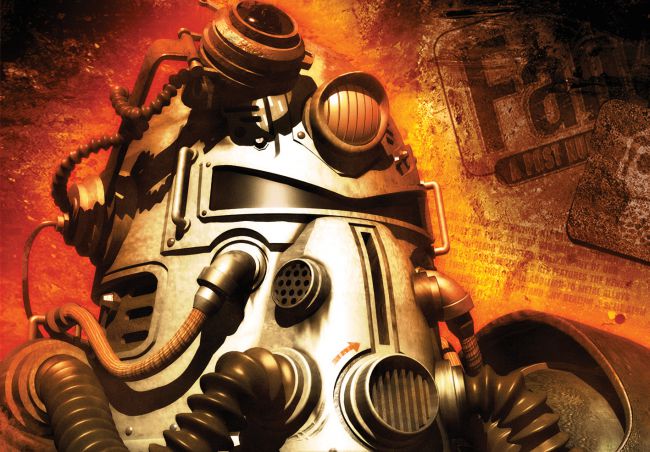
Although the war never changes , the Fallout series of games has transformed significantly over the past two decades. Starting his life as an isometric CRPG, whose roots go to board and paper role-playing games, this franchise eventually conquered the whole world.
Today, the return to the first game is annoying - Fallout 1997 was and remains an incredibly complex, uncompromising game. If you make a mistake, you will perish. Make the wrong decision - you die. If you do not make a mistake and do not accept the wrong decision, you will still perish. This is a dark and serious (for the most part) story telling us that life after the end of the world in the glow of nuclear explosions is really cruel.
“I've been a fan of post-apocalyptic literature since childhood,” says Fallout executive producer (and founder of Interplay) Brian Fargo. “And Wasteland was my first attempt to bring something new to this genre. Soon after the completion of the Wasteland game, Interplay became a publisher and we stopped working for others. I tried to get EA to license my rights back to me, but this could not be achieved for many years. Finally, I decided that we would make our own post-apocalyptic game and call it Fallout. ”
Gathering with the development team, Brian Fargo and his Interplay team analyzed what made Wasteland unique - why a computer RPG created ten years ago attracted people so much throughout this time. “We needed to put together a small team in order to start implementing the project, breathing in the soul and charm of the game,” recalls Brian. “We wrote a document that listed such important aspects as moral ambiguity, tactical battles, a skill-based system and a system of attributes. Having fixed all the most important things, we began to develop and began to work on ideas that implement the items in the list. ”
')
Tim Kane is called the creator of Fallout - after all, it was his work on the game engine that breathed life into this world, he devoted himself entirely to the project for several months. working on it alone. In earlier versions, time travel was present and GURPS rules were used, which were abandoned as a result (more on this below). “I worked on different engines, although I nominally worked on game installers,” explains Tim. “I created a voxel engine, a 3D engine, and finally got to the isometric sprite engine, which I really liked. After that, I started a combat engine based on the GURPS system, which I played on paper with my group of friends two or three evenings a week. Then some people became interested in creating the game after work, and all this gradually turned into a Fallout. ”
The development process was strongly influenced by the fact that Interplay did not invest a lot of resources in the project. “When creating the game, the formal development process of Interplay was not used,” says Tim. "She seemed to grow organically, gathering people around her and barely escaped canceling the project twice, because it seemed to the administration that these resources could be spent on something else." By "something" another meant serious licenses acquired by the studio; it seemed that if released they could bring in more money. But Tim continued to work, and together with him a team of about 30 people did something new and original, even though originally based on Wasteland.
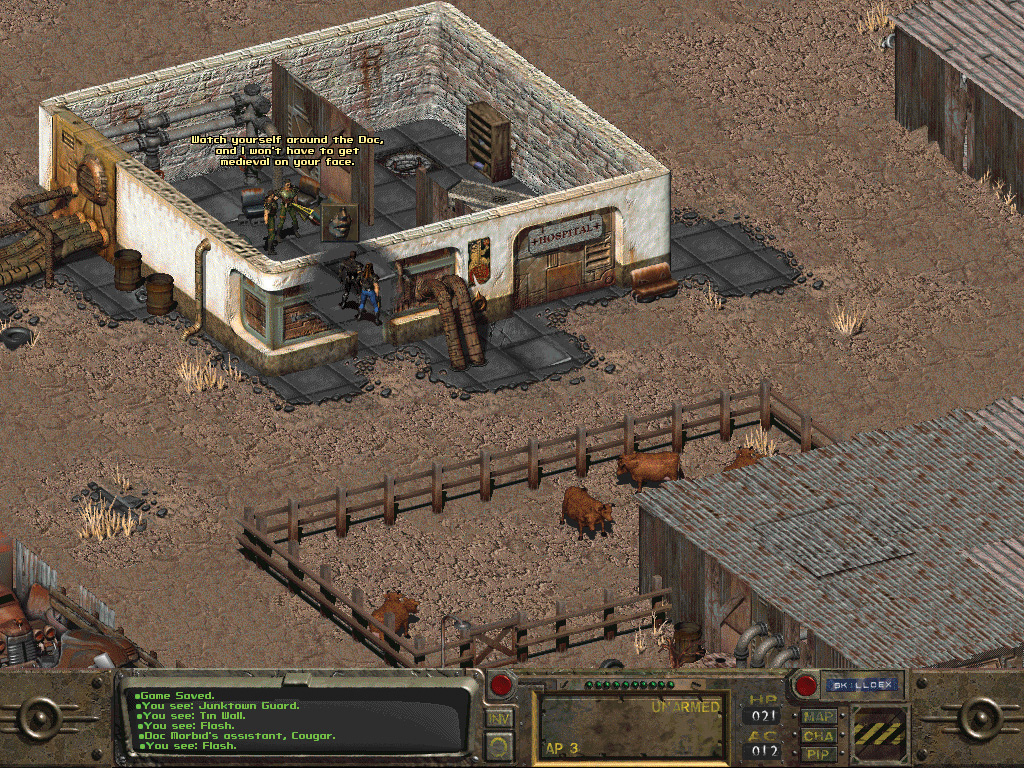
One of the systems introduced in the first Fallout was the above character creation. It turned out to be one of the few constant series: SPECIAL. Strength, Perception, Endurance, Charisma, Intelligence, Agility and Luck (Strength, Perception, Endurance, Charisma, Intelligence, Dexterity and Luck) - they all participated in creating the character image of the player. You could have become a low-IQ thug, who didn't even allow you to communicate with smarter NPCs, or you could solve problems with your wit and courteous, charismatic nature: the tools to influence the world were tuned with a deceptively simple formula.
And it could not exist. “Initially, Fallout was conceived as a game by the rules of GURPS,” says leading Fallout designer Chris Taylor. GURPS is a desktop system developed by Steve Jackson Games. The name stands for Generic Universal Role Playing System ("standard universal role playing system"). It was intended for use in all types of role-playing games, and the creators of Fallout believed that it was well suited to their project. They licensed GURPS, after which work began on Fallout: A GURPS Post-Nuclear Adventure, as the game was called first.
However, it was not so easy. “We showed Steve Jackson an introductory video in which a prisoner was shot in the head and then waving his hand at the camera, and he didn’t like it, if not more,” says Brian Fargo. "I knew what kind of world we were building, and the opening video was only warming up before the brutal world of Fallout, so I broke the deal."
In search of a replacement, Chris Taylor turned to the emerging system of rules, which he worked on in his spare time. “I wrote my own RPG system on cards, in notebooks and scraps of paper in a cage. My game was called MediEvil. She was bad. That's why my friend and I played D & D instead. But I saved these records and from time to time I worked on the game for a decade. When it was time to replace the GURPS, I already had something to work with, ”he says.
“Our team took this system and made it work. We took and adapted it; it had all the necessary statistics and skills, but “perks” (Perks) were created specifically for Fallout to replace the positive / negative traits of the character from GURPS. ”
The system is well suited to the myth, which eventually became Fallout. “The Fallout team had a very specific attitude,” Tim recalls. “We all worked together and went in the same direction. There were very few ego clashes and a desire to pull the game in a different direction. This rarely happens during the development process. ”
“Fallout has always been considered a project of category“ B ”in Interplay,” he continues. “At least until the last few months of development. I was very upset by this, because I saw in my game that which no one outside the team could see until almost its release. ”
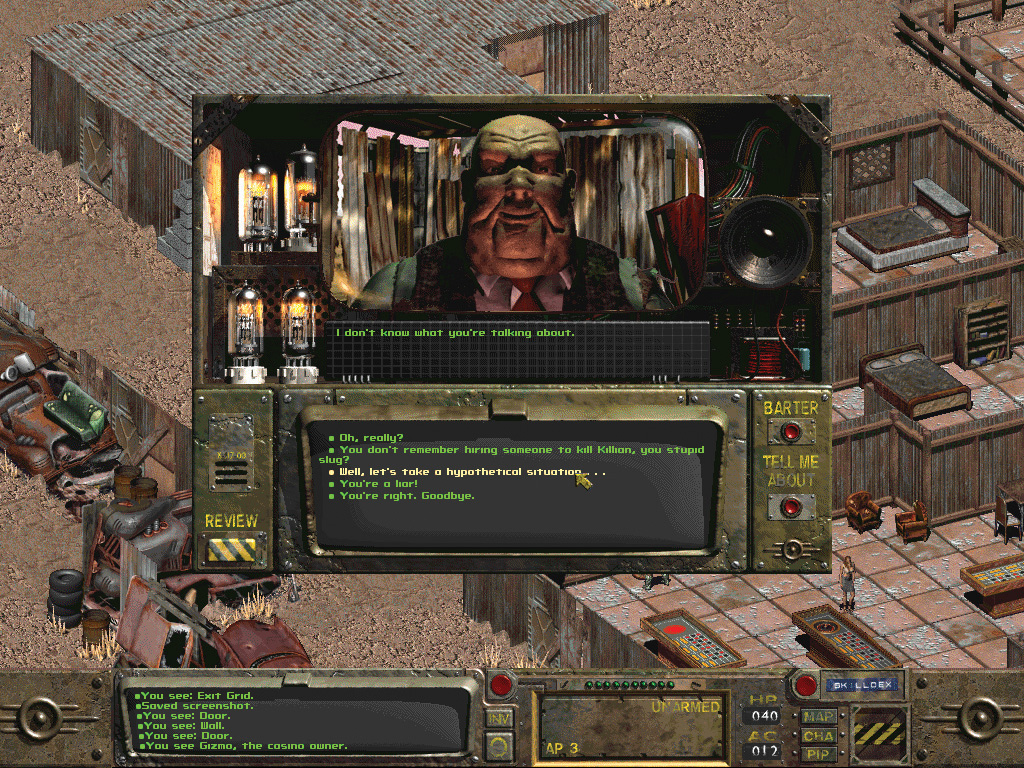
However, the team was able to see it, and those who played in Fallout were rewarded with a deep, original and incredibly gloomy view of the world destroyed by nuclear war. It was hard to survive, but the player had not only guns and knives to make his way in the world. Your words could turn out to be just as deadly, and when meeting the last boss, players with a sufficiently large charisma could even convince him to commit suicide, showing all the viciousness of his actions. For computer games of the time, this was an unprecedented feature, a testimony to the amazing work Tim Kane and his team did.
However, even before the release of the first part, work began on a sequel. “Fallout created a sensation in the studio about six months before it was released,” Tim explains. “The employees of the quality department came in the evenings and on weekends, spending their own time without pay, just to play it. Therefore, Fallout 2 began even before the Fallout release. ”
A small project for Interplay was the fruit of the love of those who worked on it, and when reviews and money for the first part began to appear, it became a business for the publisher. Fallout 2 was released exactly one year after the first part.
After 20 years, we warmly recall the sequel and we are pleased with his more lightweight look at the series.
“Behind the scenes of development, the leaders of the creative process always lead very active battles, defending their point of view,” says Brian. “But this is the essence of the creative process. The initial development of Fallout 2 was a bit painful, but apart from that, I don’t recall any particularly negative points. We had a talented team, and they all moved in the right direction. "
A remarkable fact was that Tim, along with other creators important for the first part, Leonard Boyarsky and Jason Anderson, during the creation of Fallout 2, left Black Isle Studios. Although the game was based on the ideas of this trinity (“we just left work for the whole day and brainstormed until we came to the right design, which, if I remember correctly, was accepted without any corrections,” says the art director Leonard’s games), it became a project driven by corporate requirements, rather than personal motivation, with an extremely short development cycle for such a huge project and a leadership vacuum that emerged after Tim and the company left.
“We had no idea what was going on,” says Chris Avellone, designer and screenwriter for Fallout 2 and New Vegas. “Then we heard that Fergus Urquhart gathers an emergency meeting in Black Isle and quickly distributes the design of different areas of Fallout 2, distributing the game areas to all free and even busy designers. We were all called and forced to work. At the time, I was working on Planescape: Torment, and so my parallel work on two RPGs began. ”
“It seemed to me that we lost the heart of the team,” he continues. “And all that remains is a bunch of developers who created different aspects of the game, like a huge patchwork quilt, but there was no good“ spirit ”or“ heart ”in the game, we just created content at maximum speed”.
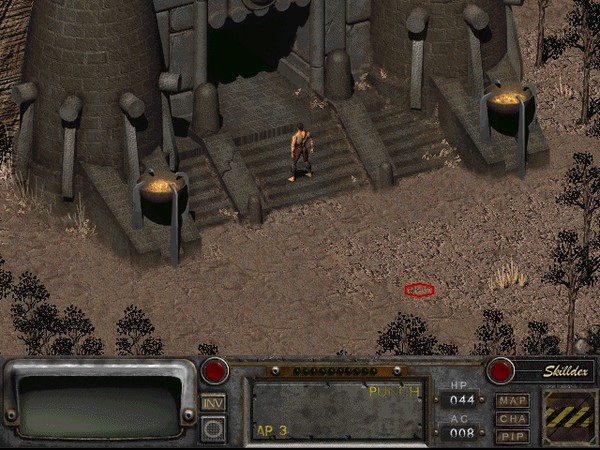
This “patchwork” approach to development led to stylistic differences in Fallout 2. The first game was grim, in the second there were clumsy references to Monty Python, Hitchhiker's Guide to the Galaxy, Godzilla and much more. Yes, some were really funny, but many missed the mark. “I think that basically the loss of gloom was caused by the departure of Leonard and Jason,” Tim Kane explains. "In addition, after my departure, I rejected my personal rule:" no jokes or cultural references that would make no sense for a player who does not understand them "."
“Fallout 2 was a sloppy project without serious control. The leadership did not have enough time, ”says Avellone. “As a result, people threw elements into the game that seemed ridiculous to them, even things like character models that we didn't even know were in the game.”
Bouncers in felt hats and with Thompson's guns from New Reno, whose models do not match the style of the game, were handed over to Chris Avellone even without his approval. “They were just made,” he explains. “And I had to use them, even though they did not fit the style. As a whole, New Reno itself did not correspond to it very much, although it was possible to create many things that are applicable in the city. ”
Throughout the game there is something to do. The game itself was not so different from the first part, but still fascinated, and the difference in intonation from the first game actually increased the army of fans, and to this day requiring more humor in the Fallout games. And when Fallout 2 wanted to become serious or show the player the consequences of his actions, it was possible to find out what would happen if, for fun, to tattoo the word “slave owner” on your face (spoiler: this will essentially destroy your game, because almost no important character will not want to talk to you).
Fallout 2 was released about a year later, in contrast to the first part, the creation of which took three years. During this time, the team created a new part of the world to explore, a large number of new storylines, and even allowed the player to travel by car. It was an impressive opportunity, even though it annoyed some Fallout fans. However, the creator of Fallout still has a positive attitude towards it, even after leaving the project. “I was always impressed by how the team managed to create a game much larger than the original and at the same time three times faster,” says Tim Kane. "They should be incredibly proud of this achievement."
The problems that have arisen in the intricate development of Fallout 2 have become a pattern for Interplay for the following years, and the second game was the last in the basic series released by this publisher. It cannot be said that he did not try to release a lot of projects, but all of them were not successful as a result. In the period between the second and third games, a couple of releases appeared: one had some good ideas, it is better not to remember the second one. But be that as it may, Fallout was not even far from dying.
In 2001, Fallout Tactics was released: a spin-off series entirely focused on the combat aspects of the first two games. It was a worthy foray into the world, reminiscent of the Jagged Alliance, although its “tactical” aspect was a bit lost and the battles were often thoughtless skirmishes.
“I was very pleased with what Micro Forte developer did at Fallout Tactics,” says Chris Taylor, who worked as the lead game designer. “But I must admit that this is not exactly the project that we saw in the early stages of preproduction. As long as the games remain just ideas, it is easy to get excited about their concept. But then his reality takes. You have to make compromises. In the case of Fallout Tactics, we released the game earlier than necessary. It was possible to spend a little more time on revision. "

Although Tactics was well received by some, and over the years, her reputation has increased, another spin-off that she tried to release - Fallout: Brotherhood Of Steel - received a less warm welcome. The “consolidated” version of Fallout, similar to Baldur's Gate: Dark Alliance, the game was weak at best, and at worst a spot on the series’s reputation. But Interplay didn’t pay much attention to the spin-off, she was busy working on the real Fallout 3.
Interplay's attempt to create Fallout 3, codenamed Van Buren, never got to the finished state and was canceled. "By this time, Brian Fargo left the team," explains Chris Avellone. “And the vision of the company went with him. Although we knew that the company needed to make a profit, this feeling reached us too. ” The first Fallout 3 was canceled, then the franchise was transferred to other owners, and the original owner lost all rights to Fallout.
In 2008, Bethesda studio, which developed the first-person role-playing role-playing game series Elder Scrolls, released its own version of Fallout 3. It became a huge hit, plunging players into the reality of the post-apocalyptic wasteland in Washington's place. The game has changed significantly, while at the same time retaining its foundations, such as SPECIAL and the aiming system VATS. The world was new and delightful, but at the same time completely familiar.
“At that time, we had a constant need to make Bethesda Game Studios more than just the Elder Scrolls team,” explains Fallout 3 lead producer Gavin Carter. “We thought a lot about what could be our second major project. I don’t remember the exact moment when it turned out that it would be a fallout, but it definitely happened during such discussions. I remember how my attitude quickly changed from "wouldn't it be great" to "maybe we have a chance, but don't be too hopeful," and then it's time to start planning the project. "

In Fallout 3, a detailed and extensive world was realized, which the player looked at with his own eyes. At the same time, the game returned to a more serious tone of the first part. After all, war must be a hell of a reminder. The change of tonality, according to Gavin, was intentional: although the second part of Fallout remains a hit for all times, these elements seemed to be an interference to the Bethesda team. “We wanted to more fully realize the vision of the post-apocalyptic future,” he says. "And it seemed that humor destroys this feeling more than complements it."
The transition from the usual fantasy studio to science fiction has become a complexity, the solution to which the developers willingly took up. Although later detractors will call it “Oblivion with guns,” in fact, Fallout 3 was a huge achievement for Bethesda and for the series as a whole. And unlike in previous years at Interplay, the experience for this team was positive. “I remember how people worked for months to properly implement the plot of Liberty Prime,” says Gavin Carter. “The development team of the PS3 version worked hard for months on fixing the bug with the departure of VATS. People played with VATS after Todd Howard, a computer programmer and artist, pored over him for two weeks and finally made him work. I remember meetings on concept reviews: "Sorry, but this minigun is too much like a Dyson vacuum cleaner." One day, our video effects artist closed the curtain and posted a warning sign because he was looking for references on the dismemberment on the Internet. When we first started shooting limbs, we tested it, shot 3D people again and again. ”
Bethesda then returned to the Elder Scrolls series, moving on to developing a project that would later turn into Skyrim. But she didn’t want to leave Fallout, so she turned into Obsidian Entertainment’s studio, which employed many people who created the first two Fallout games, as well as the canceled Van Buren. “The team worked on DLC Fallout 3 and was delighted with Skyrim,” explains Gavin. “Therefore, they realized that we cannot do everything ourselves. I also think we realized that the decision to work with Obsidian, given their history of relationships with the franchise and the quality of the results, was a smart move. ” Fallout: New Vegas turned out to be an excellent result, considered to be the best modern game in the series, however, it also had difficulties in developing it.
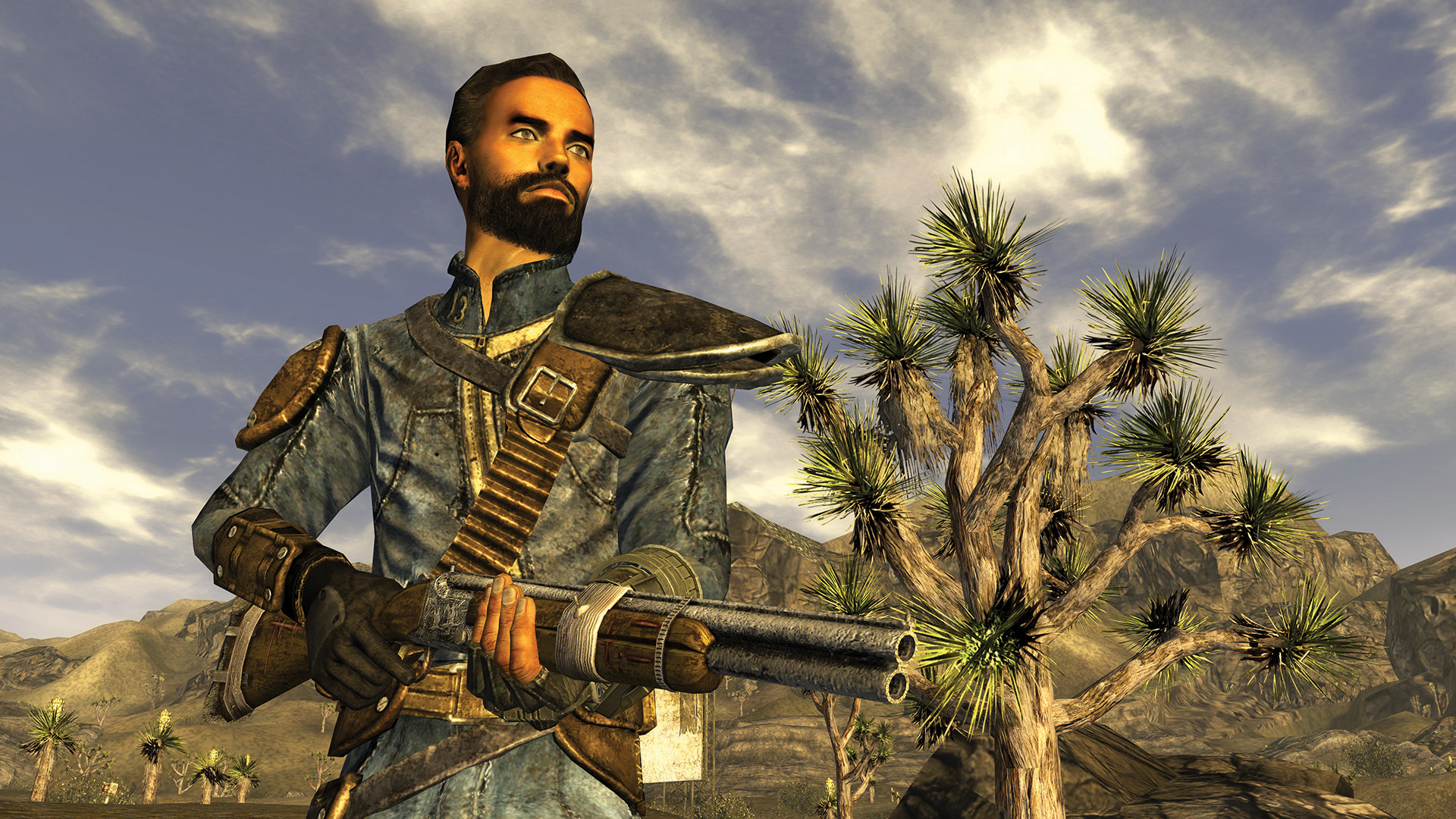
“The biggest challenge was the scale of the game,” explains Chris Avellone. “The game was too big, and they put too much into the schedule; the release date was approaching, but there were still bugs in the game, with which no one did anything. ” Then there were patches, but they influenced the DLC coming out soon, and to solve the problem, more work was needed, and this process was repeated. “It was even harder than it looks,” Chris continues. "Because patches and fixes changed the balance, and this sometimes destroyed the optimal quest process."
New Vegas was full of bugs, and for this he was actively criticized. And then there was a sad incident with ratings on Metacritic: according to the contract, Obsidian should have received royalties for the game if she received a rating of 85 or higher on Metacritic. New Vegas scored only 84.
Despite all this, New Vegas has become a cult classic and among a certain portion of Fallout fans is considered the best game of the series. Corrected with subsequent patches and complemented by superb DLCs, New Vegas has become the perfect balance between Bethesda’s new 3D approach and commitment to traditional Black Isle / Interplay RPG mechanics.
Of course, Bethesda later returned to her science fiction series of games, releasing Fallout 4. With this, she took another step away from the pure form of the original, adding construction and crafting elements to the game. Despite the good reception, the fourth part could not satisfy the old school fans. Is this a good game? Definitely. Great game of the Fallout series? And this is a controversial issue.
Since its inception, the Fallout series has changed significantly, probably much more than any other series in the history of video games. However, at the same time, its main themes after decades are still the apocalypse, the fundamental nature of man and the need for support in the conditions of survival. It has transformed, but is still loved even by its creator, who has long since moved away from development. “Fallout will always be my child, albeit adopted by another family,” says Tim Kane.
An added bonus to the success of Fallout was the revival of the series, which was its source of inspiration. The current studio of Brian Fargo InXile managed to raise crowdfunding funds for Wasteland 2. “Everything I learned from Wasteland, I invested in Fallout, and everything I learned from Fallout, I invested in Wasteland 2,” Brian Fargo tells us. We conducted this interview in 2014 and at that time work on Wasteland 3 had already begun, to which none other than Chris Avellone contributed. “In Wasteland 3 there is a lot from Van Buren,” he says. “Working in tandem with lead designer George Zits, we used many of Van Buren’s foundations in Wasteland design. He took the high-level concepts and adapted them to the Fallout universe. ”
In the meantime, Bethesda has produced something that we never expected to see: the online version of Fallout. About the connection of multiplayer and survival in the wastes was spoken from the very beginning of the series (and tried to implement it), but it took 21 years to implement. Fallout 76 is a weak attempt that failed to reach its potential, but the series is too popular to suffer from it. The return of Fallout in single-user form is likely to occur after the release of the upcoming Starfield and Elder Scrolls 6, which Bethesda will spend many years. We will wait for the day when the series again plunges the world into flames.
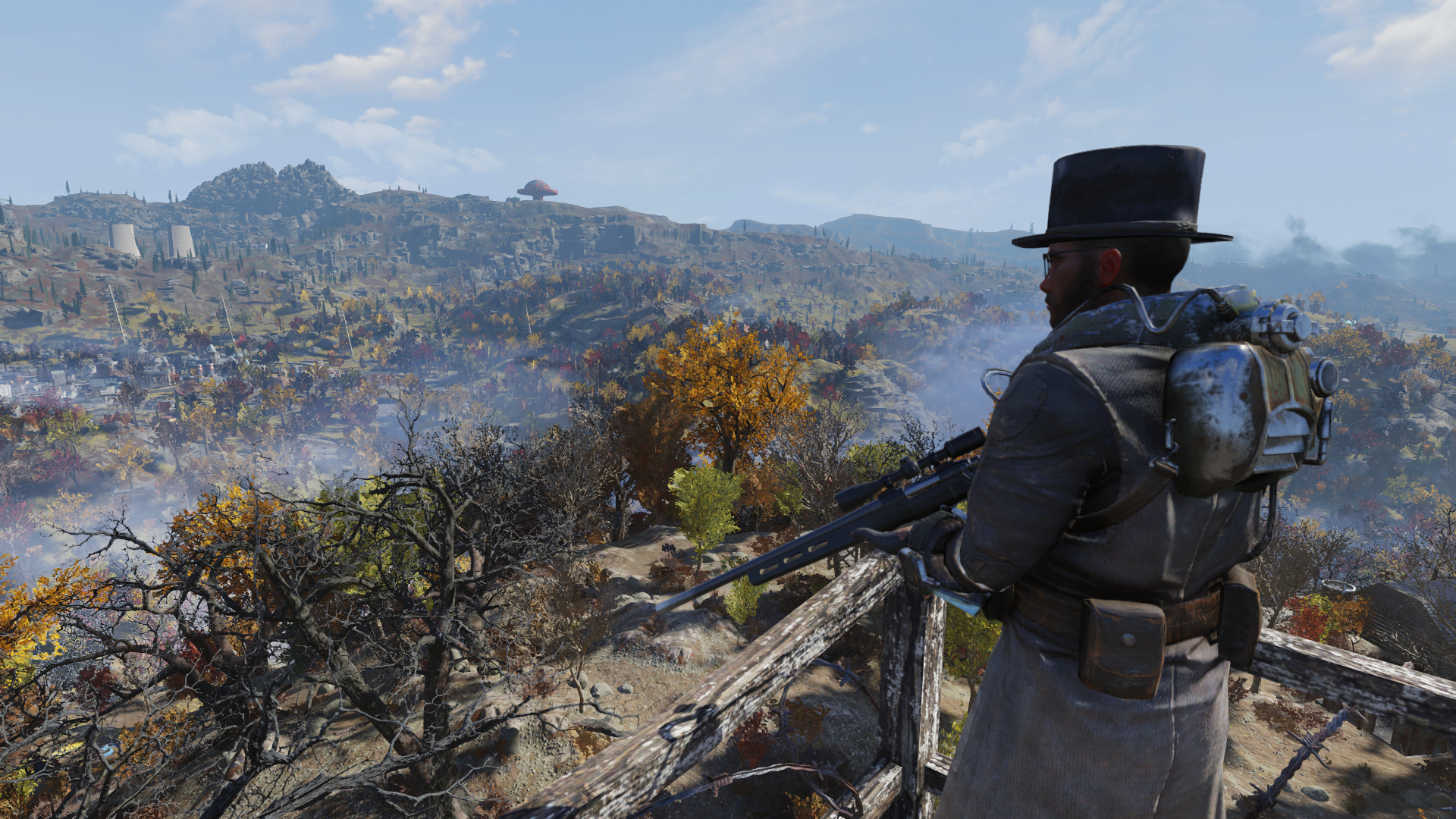
Apocalypse Survivors
People
Not just ordinary people, but also dwarfs, animals, swamp folk and others. People are the most common species in the post-apocalyptic landscape, despite the fact that it was they who caused this nuclear madness. However, only one thing is certain in the wastelands: man is not very kind by nature.
Guli
Five million people who have forgotten to hide from the scorching nuclear glow, turned into radioactive skinless ghouls. Many of them with whom you happen to meet, work and act almost like real human beings. For some, the long-term effects of radiation burned out their brains and they roam the plains like zombies.
Super Mutants
People who have been "dipped" in the slush of a man-made evolution virus (Forced Evolutionary Virus, FEV) sometimes (not always) turn into super mutants: huge goons, usually stupid, sometimes smart, but always extremely dangerous. They are present in the series from the first part and are usually antagonists, although the player may encounter friendly instances.
Robots
Robots of various shapes and sizes are often found in all games of the series. They are friends or enemies; The style of the 50s is very conducive to the formation of their appearance. Look at least at the standard protective protectrons, similar to the characters of old science fiction films.
Aliens
For the first time, aliens appeared alive only in the third game, but many of the collapsed spaceships could be found in the wasteland from the first part. Intelligent and insidious, these guys are rare and mysterious; rumor has it that they could be the cause of the Great War.
Sint
Sinthe - one of the few new technologies that have arisen after dropping bombs. Based on pre-war technologies, synths are designed to imitate a person and should not differ from him. Nick Valentine, considered one of the best partners in Fallout - synth; However, it is quite simple to determine.

Strange Easter Eggs in Fallout Wastes
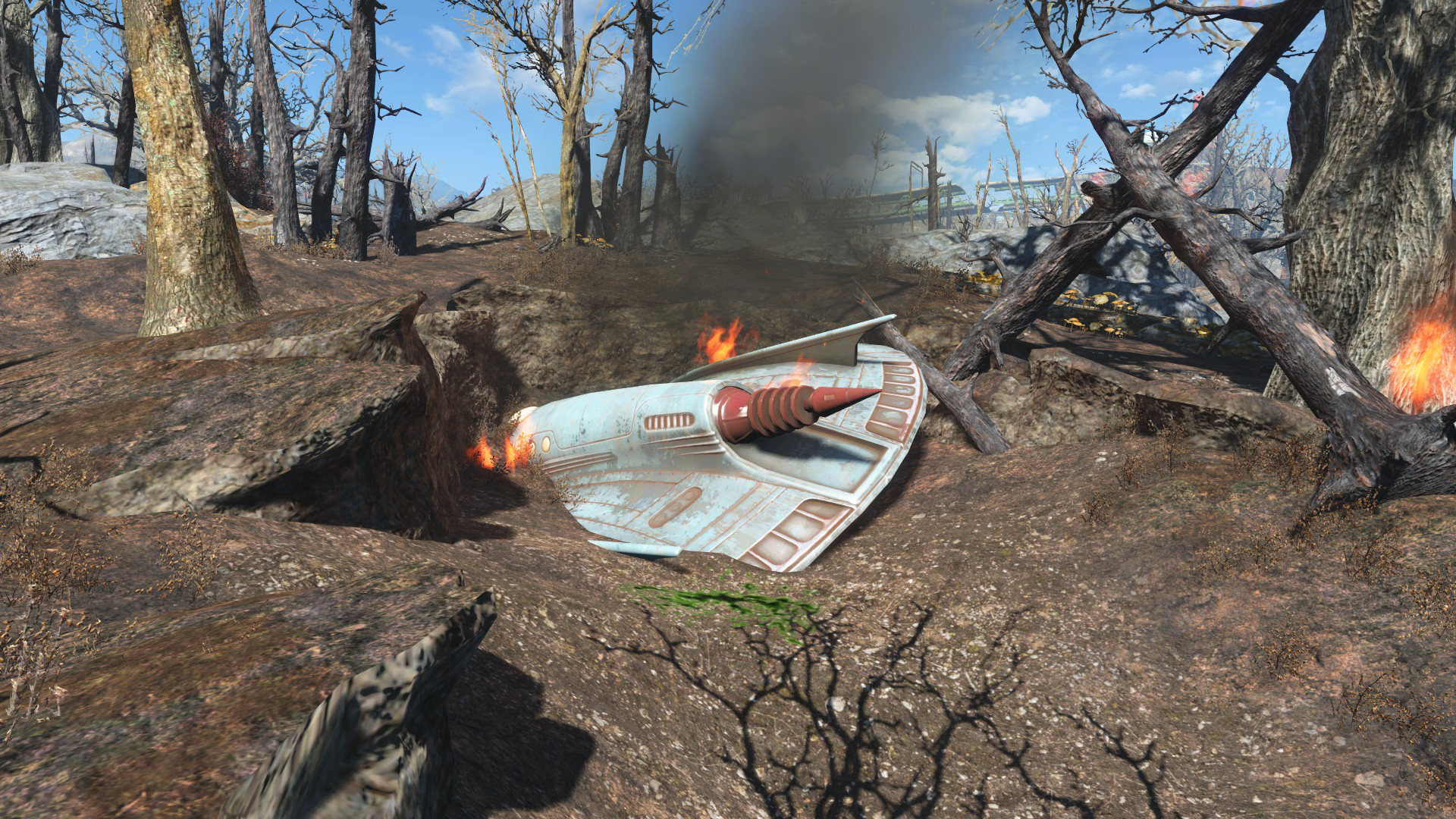
Crashed UFO
Fallout 1-4, New Vegas
Where Fallout, there crashed flying saucers. And usually very good alien loot, for example, terribly useful and powerful Alien Blaster. Keep getting into accidents, alien friends.
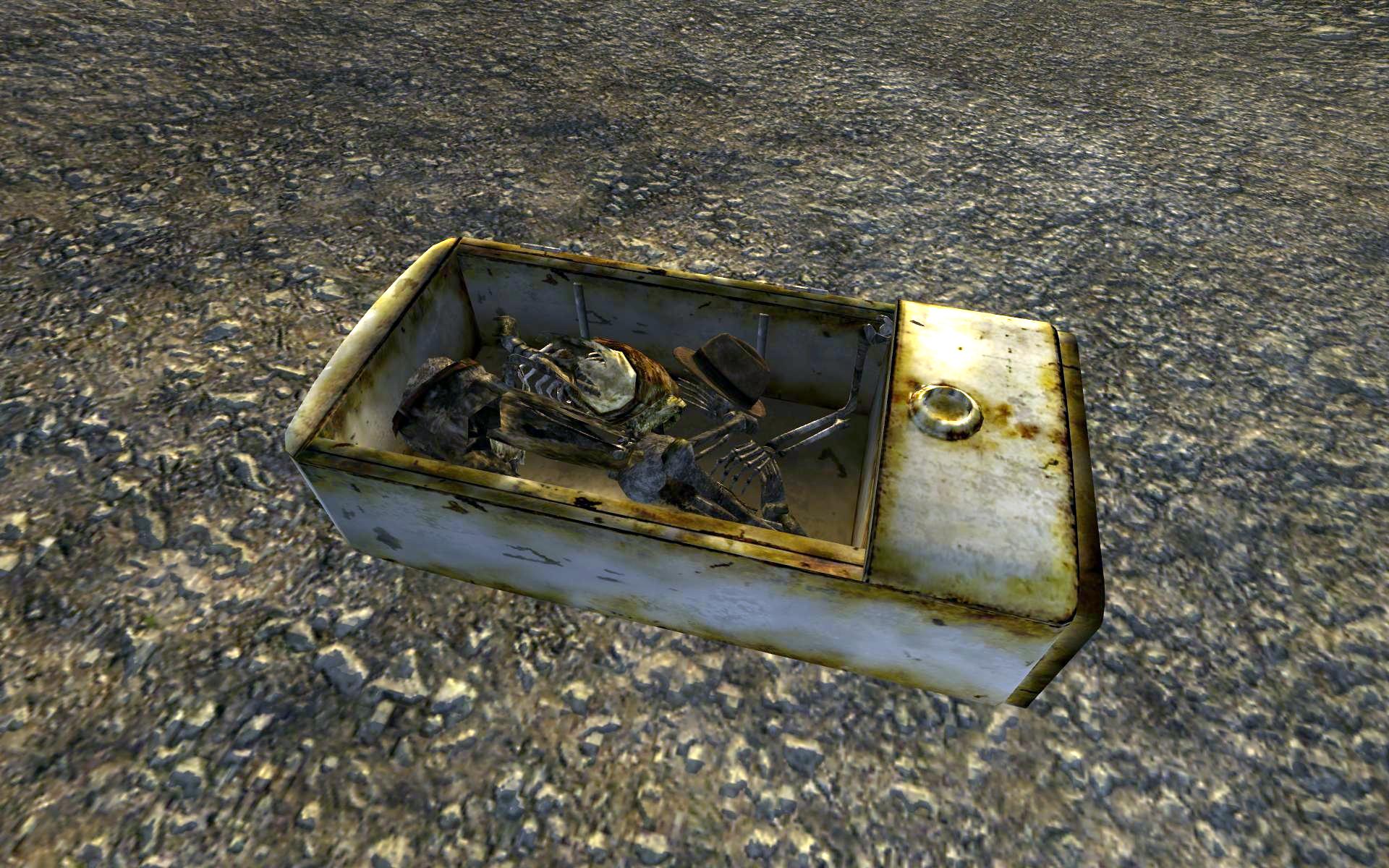
Search for the lost refrigerator
Fallout: New Vegas
A more realistic version of the scene that we tried to forget: Indiana Jones is hiding from a nuclear explosion inside the fridge. In this version only a skeleton and a hat are left.
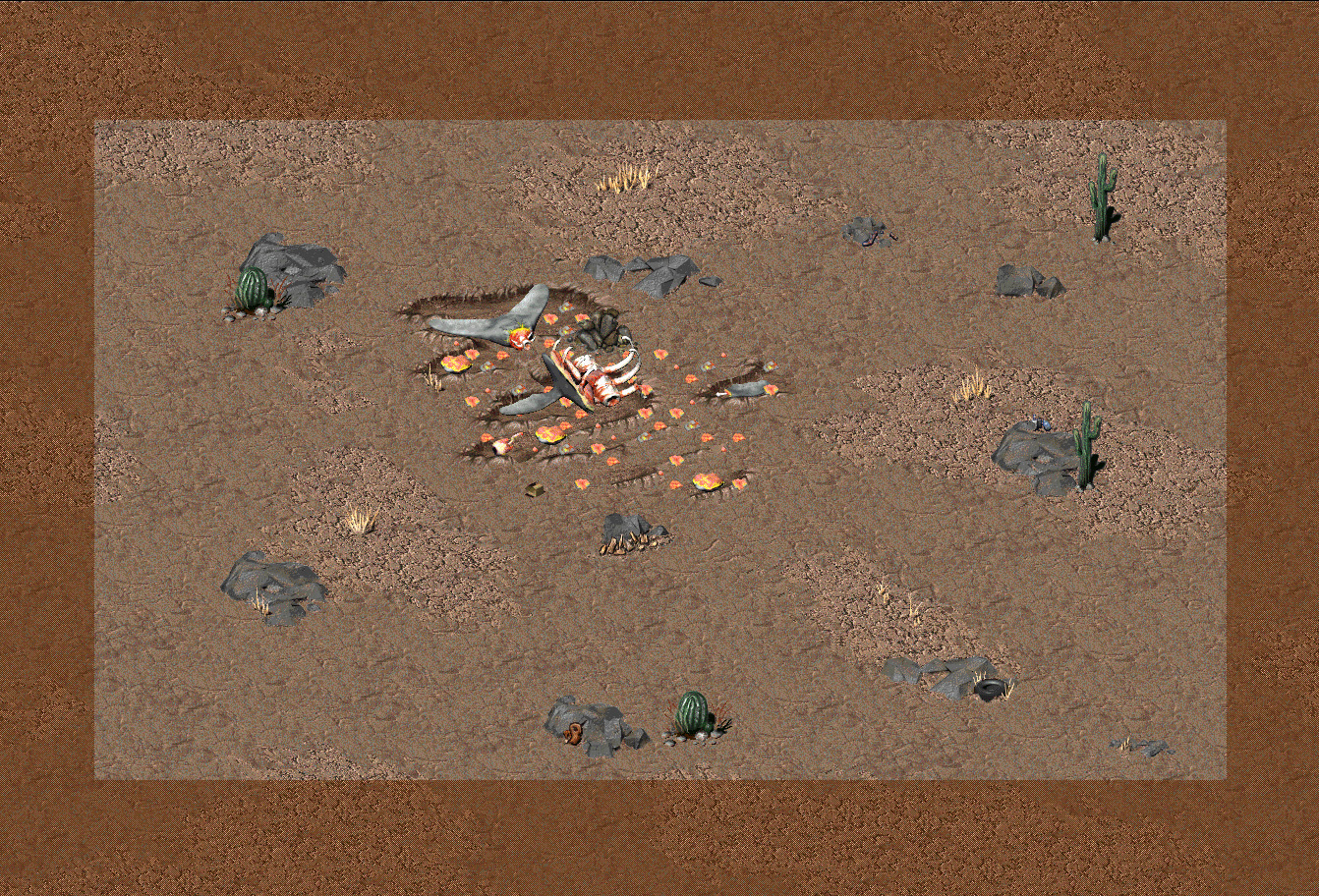
"Do not panic!"
Fallout 2
“Hitchhiker's Guide to the Galaxy” is a familiar source of quotations for Nerds, and Fallout 2 was no exception. The whale fell from a great height, but it was not this that killed him, but a sharp stop.
Old scrolls
Fallout: New Vegas
A badge of gratitude to those to whom modern Fallout games should be grateful for their existence: on some lanterns on Friside, TES-04 is engraved; this is a reference to Elder Scrolls IV: Skyrim, which was still in development [approx. Trans .: in fact, Elder Scrolls IV was Oblivion] .
Monty python
Fallout 2
The player meets in the wasteland a strange group of people, the so-called "knights", headed by a man named Arthur. They travel in search of a “holy hand grenade”. You can pretend that you want to help, but they still don’t know where the GECK is.
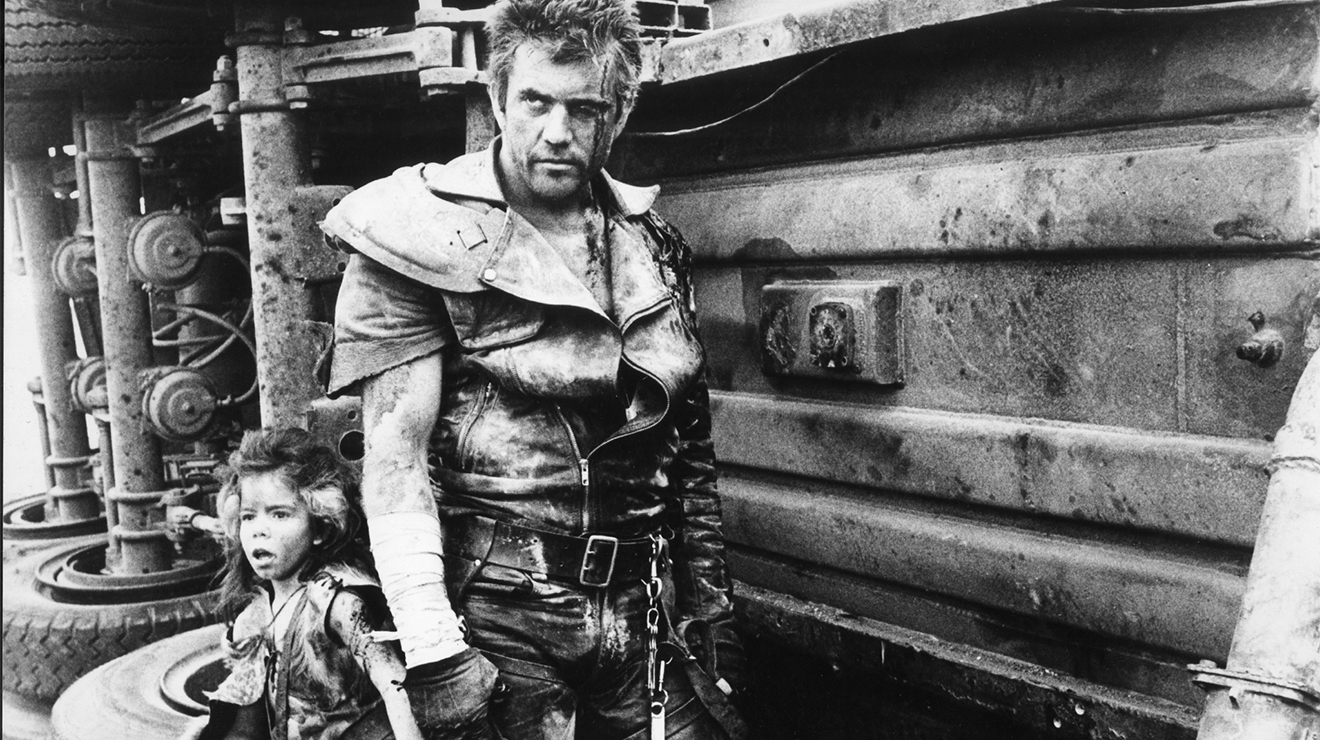
Mad Max
Fallout 1-4, New Vegas
Leather armor and the Fallout series are now inextricably linked, so it's easy to forget that this outfit is based on Max Rokatansky clothes from Mad Max movies. It is a pity that in the games you can not find "Interceptor" (Interceptor).
Tardis
Fallout
This episode is quite recognizable: you are in the wasteland, find an old police box, its lights begin to flash and it disappears. You are in the Doctor Who universe.

Gone with a Nuclear Explosion - Canceled Fallout Franchise Games
Fallout Extreme (PS2, Xbox)
Canceled: in 2000, the
tactical first-person or third-person shooter never got out of the concept-art stage. And it's sad, because by descriptions it looked like Hired Guns in the Fallout universe. The planned storyline was to throw players away from the United States, on such territories as Russia, Mongolia and, finally, China. The Fallout game for the first time was to leave the States. Extreme was canceled almost immediately after the creation of general sketches and concept art.
Fallout Tactics 2 (PC)
Canceled: in 2001
Around the time of the release of the first Tactics, work began on the pre-production of the sequel. Unfortunately, sales of the first game did not reach the expected level, and Interplay canceled the project. Only the sketches of mutant crocodiles who were supposed to live in places like Florida, as well as the general idea of the plot in which the radiation-infected GECK was involved, survived to this day. The resulting mutated paradises of heaven would be an interesting plot twist for the Fallout series, the eternal task of which was to restore the ideal world.
Van Buren (PC)
Canceled: in 2003
This initial version of Fallout 3, which was created based on the Baldur's Gate 3 engine (also canceled), was developed under the direction of Chris Avellone and Josh Sawyer, who later created New Vegas. The game was supposed to take place in Arizona, Nevada, Colorado and Utah, and the player was originally in the role of a prisoner. The project made some changes to familiar systems, for example, in SPECIAL. A technical demo was released, but in the end Interplay decided to redirect funding to Icewind Dale, and the project died.
Fallout: Brotherhood of Steel 2 (PS2)
Canceled: in 2004
There is a twofold attitude to this game: on the one hand, it is sad that BOS2 never came out because it was close to completion when development stopped due to staff reductions at Interplay. On the other hand, the first part was pretty awful, so the loss does not seem so strong. In the sequel, elements such as the Caesar Legion and the Jackals, borrowed from Van Buren, followed by New Vegas, and the radioactive GECK once again appeared. However, the game is not released.
Project V13 (PC)
Canceled: in 2012
V13 — Interplay Black Isle Studios. MMO Fallout Online: Masthead Studios, Interplay . Bethesda, . V13 Fallout, , - , .

Source: https://habr.com/ru/post/446968/
All Articles